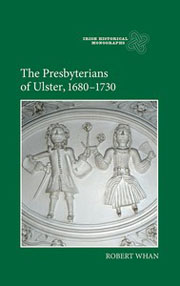Book contents
- Frontmatter
- Contents
- List of Illustrations
- Acknowledgements
- Colophon
- List of Abbreviations
- Editorial note
- Map showing principal places mentioned in the text and approximate presbytery boundaries (1704)
- Introduction
- 1 Ministers
- 2 Gentry
- 3 Merchants and Commerce
- 4 The Professions
- 5 The Lower Orders
- 6 Organisation and Religious Practice
- Conclusion
- Bibliography
- Index
Introduction
Published online by Cambridge University Press: 05 March 2014
- Frontmatter
- Contents
- List of Illustrations
- Acknowledgements
- Colophon
- List of Abbreviations
- Editorial note
- Map showing principal places mentioned in the text and approximate presbytery boundaries (1704)
- Introduction
- 1 Ministers
- 2 Gentry
- 3 Merchants and Commerce
- 4 The Professions
- 5 The Lower Orders
- 6 Organisation and Religious Practice
- Conclusion
- Bibliography
- Index
Summary
Presbyterianism came to Ulster with the arrival of Scottish settlers in the seventeenth century. By 1700 Presbyterians formed more than half of Ulster's Protestants and were the dominant confessional group in Counties Antrim and Down, as well as in certain parishes of Londonderry. Despite this we know far less about the Presbyterian community than we do about the Anglican Protestants of Ireland. The social structure and material culture of Irish Protestants have been examined by Toby Barnard in his New anatomy of Ireland and Making the grand figure. Barnard's work, however, focuses on Anglicans rather than the entire spectrum of Protestantism, and as he himself admits Ulster, particularly its Presbyterian society, is under-represented. This book will correct this significant gap in Irish historiography by looking at the Presbyterian community in Ulster and the degree to which it provided an alternative Protestant society in Ireland.
To date, scholarly study of seventeenth- and eighteenth-century Ulster Presbyterianism has focused chiefly on the arrival of Presbyterianism in the early seventeenth century or the involvement of Presbyterians in the United Irish movement at the end of the eighteenth century. In contrast, the period from 1680 to 1730, with the exception of denominational historians interested in the Subscription Controversy of 1719 to 1726, has been largely ignored by historians. Yet, it was a significant, and defining, period in Presbyterian history. For Finlay Holmes, 1690 marked the ‘end of the beginning of Irish Presbyterian history’ and both Raymond Gillespie and Richard Greaves have demonstrated how in the three decades after 1660 the Presbyterian church reached maturity and had become a sustainable and viable denomination.
- Type
- Chapter
- Information
- The Presbyterians of Ulster, 1680-1730 , pp. 1 - 14Publisher: Boydell & BrewerPrint publication year: 2013

